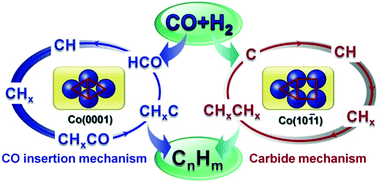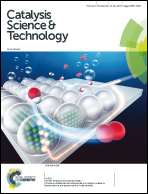First-principles study of structure sensitivity of chain growth and selectivity in Fischer–Tropsch synthesis using HCP cobalt catalysts†
Abstract
Structure sensitivity on chain growth and selectivity in cobalt catalyzed Fischer–Tropsch synthesis (FTS) were studied by density functional theory (DFT) calculations. It is found that at a lower CO coverage, chain growth tends to proceed via a CO insertion mechanism on close-packed Co (0001) and stepped Co, with CH4 as the main product. However, a carbide mechanism is preferable on more open Co (10![[1 with combining macron]](https://www.rsc.org/images/entities/char_0031_0304.gif) 1) accompanied with higher selectivity to C2 hydrocarbons than CH4. The origin is identified from the structure sensitive adsorption of the key intermediates, specifically the least “saturated” C/CH species, which exhibit a relatively strong dependence on the structure evolution. With increasing CO coverage, the CO insertion mechanism becomes more favorable, and both FTS activity and C2 hydrocarbon selectivity increase on Co (0001). This work highlights the intrinsic structure and coverage effects, achieving fundamental insight that can potentially be used to design and develop improved catalysts for FTS and other important reactions in syngas conversion.
1) accompanied with higher selectivity to C2 hydrocarbons than CH4. The origin is identified from the structure sensitive adsorption of the key intermediates, specifically the least “saturated” C/CH species, which exhibit a relatively strong dependence on the structure evolution. With increasing CO coverage, the CO insertion mechanism becomes more favorable, and both FTS activity and C2 hydrocarbon selectivity increase on Co (0001). This work highlights the intrinsic structure and coverage effects, achieving fundamental insight that can potentially be used to design and develop improved catalysts for FTS and other important reactions in syngas conversion.

- This article is part of the themed collection: 2017 Catalysis Science & Technology HOT Articles


 Please wait while we load your content...
Please wait while we load your content...